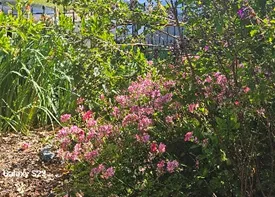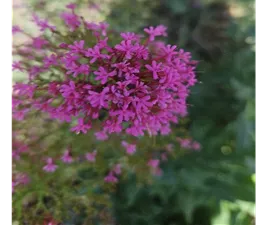Blog by Nancy Forrest
I had the pleasure of being a host for the Vacaville Museum Garden Tour in May. I was lucky to be at a home that was built by the Master Builder George Sharp for his daughter in 1918. The current owner moved into the house after his mother passed in 2013. As his mother was an avid organic gardener, he currently lives by the notion “no greenery leaves the property, unless a weed.” He has spent the past few years tearing out his lawns and replacing them with raised flower beds. He has replanted his mother’s daffodils, iris, calla, cannas, agapanthus, amaryllis, as well as, 101 other plants. The quince bushes, the lemon, peach, orange and pluot trees, have been there since the 1970’s. His property has two compost piles, a vegetable garden, and remnants from an old oak tree. He has focused his plans on being bee and butterfly-friendly. I took some pictures of some of the plants that I particularly liked: Red Hot Poker, garden geranium, alfalfa, and Red Valerian.
The Red-Hot Poker (Kniphofia uvaria) also known as Torch Lily or African Poker, is an herbaceous perennial. It is native to South Africa and is widely grown for its showy, torch-like flower spikes. The bright, tubular-shaped flowers are highly attractive to hummingbirds and butterflies. Planting them in your garden is a surefire way to invite these beautiful creatures to pay you a visit. As a bonus, the plant is drought-resistant.
The Garden Geranium (Pelargonium X hortorum) is a hybrid species and is a popular ornamental plant worldwide. The plant produces beautiful flowers in an assortment of colors and is easy to care for and to display in planter boxes. But what you may not know is that they are edible. Due to the essential oils in their leaves, they can add an exotic aroma and enticing flavor to various salads, desserts, meat dishes, and baked goods. Remember, the flowers are also visually appealing and make beautiful garnishes for any dish.

The Alfalfa (Medicago sativa), also known as Lucerne, is a perennial flowering plant characterized by small purple or blue flowers. As a member of the Legume family, it is frequently cultivated as a forage crop for cattle and utilized in hay production. Additionally, alfalfa contributes to soil improvement and serves as a food source for pollinators. While all parts of the plant are edible, the leaves tend to become bitter as they mature. The purple blooms can enhance the flavor of salads, and alfalfa sprouts are commonly grown for consumption.
The Red Valerian (Centranthus ruber), also known as Jupiter’s Beard, is an Old World wildflower. It produces clusters of bright pink to red flowers that bloom from late spring to early fall. A tough, durable plant, it thrives with minimal water and care once established. Butterflies are frequent visitors, benefiting from the abundant nectar and pollen. It’s drought-resistant/drought-tolerant plant and not recommended for coastal areas of CA, WA and OR, where it can behave aggressively.

NOTE: Please be sure to identify any plant prior to consuming it.
thumbnail photo: "Anise swallowtail on Jupiter's beard" by TJ Gehling is licensed under CC BY-NC-ND 2.0.

